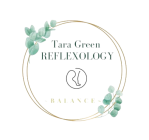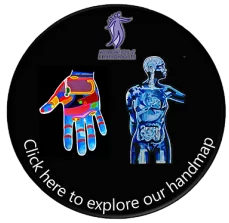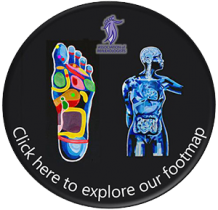About Reflexology
What to expect
When you book your first appointment with me, before we begin, I will ask you to fill out a questionnaire, giving some details about your medical history and any condition that is troubling you. I will then use this information to completely tailor the reflexology to your specific needs. We will also discuss your treatment and you can ask any questions you may have about reflexology.
During your treatment, I will encourage you to take deep breaths, relax and close your eyes. Only when you are relaxed and comfortable will you feel the benefits of reflexology. It is a quiet and meditative process through which you can relax and reconnect.
I apply pressure to your reflexes using my hands and fingers. This pressure is firm, but it is not painful. We can discuss your level of comfort during the treatment so I can tailor my techniques accordingly.
During the session, I use a range of reflexology products. All products are organic and natural.
Treatments
Hand and Foot Reflexology
Hand reflexology and foot reflexology are both forms of reflexology that involve applying pressure to specific points on the hands and feet to promote healing and balance in the body. However, there are some key differences between the two techniques.
The main difference between hand reflexology and foot reflexology is the location of the reflex points. In foot reflexology, the reflex points are located on the soles of the feet, while in hand reflexology, the reflex points are located on the palms and backs of the hands. The reflex points on the hands and feet correspond to different parts of the body, so the techniques are similar in terms of their overall goal of promoting balance and well-being.
Another difference between hand reflexology and foot reflexology is the level of pressure that is applied. Because the hands are more sensitive than the feet, hand reflexology typically involves less pressure than foot reflexology. Hand reflexology may also involve more gentle stretching and massage of the hands, while foot reflexology may involve deeper pressure and manipulation of the feet.
Overall, both hand reflexology and foot reflexology are effective forms of reflexology that can help to promote relaxation, reduce pain and tension, and improve overall well-being. The choice between the two techniques may depend on individual preference, as well as the specific condition being treated.
Spinal Foot Reflexology
Spinal foot reflexology is a specific type of reflexology that focuses on the feet and their connection to the spine. It is based on the theory that there are reflex points on the feet that correspond to different parts of the spine, and that by applying pressure to these points, it can help to alleviate pain, improve circulation, and promote relaxation and balance throughout the body.
During a spinal foot reflexology session, I use my hands and fingers to apply pressure to specific points on the feet that correspond to different parts of the spine. The pressure is applied in a specific sequence, with the goal of stimulating the body's natural healing processes and promoting overall wellness.
Like other forms of reflexology, spinal foot reflexology is a complementary therapy that can be particularly helpful for people who suffer from back pain, sciatica, and other spinal conditions, as well as for those who are looking to promote overall health and well-being. In many cases it can also help with headaches and the symptoms of long covid.
Facial Reflexology
(Bergman Method)
Facial reflexology, similar to foot reflexology, promotes inner balance and harmony while enhancing the skin’s natural radiance and beauty. This holistic technique is designed to support optimal body function, with the added benefits of a firmer, glowing complexion that uplifts both appearance and mood. Because of the face’s proximity to the brain and cranial nerves, facial reflexology is particularly effective in supporting the body’s systems. By applying pressure to reflex points on the face, this practice stimulates the body’s natural healing processes, improves circulation and nerve conduction, and promotes toxin release through the lymphatic system.
Zone Face Lift
Zone Face Lift is a holistic facial treatment that combines traditional reflexology methods, pressure-point massage and ancient healing techniques from Native American shamans to look and feel the best version of yourself.
After many years of studying in Japan, Borneo,
Thailand and New Mexico with Native American shamans and healers, leading
facial reflexologist Ziggie Bergman (my tutor) developed this treatment
This treatment is often referred to as a natural alternative to botox or fillers. It focuses on stimulating specific reflex points on the face to improve skin tone, reduce wrinkles, and lift sagging areas, while also promoting relaxation and emotional release.
The face will be sculpted, toned and lifted using unique techniques and the award winning Zone Face Lift Elixir. Each session will be customised to focus on your specific needs and includes the use of specialised tools like mushrooms, gua sha and an acupressure roller.
Lymphatic drainage is a key area of focus, a process that helps remove toxins, reduce puffiness, improve circulation and promote a brighter, healthier complexion. If suitable, this treatment closes with either palo santo or sage ‘smudging’ to release negative energy and attract the positive.
The Zone Face Lift treatment goes beyond skincare, providing a comprehensive, holistic experience that enhances both the appearance and the overall wellbeing of the client.
Zone Face Lift 12 Week Programme is a transformational journey both inside and out.
Aftercare
The effects of reflexology continue long after your treatment has ended. You may feel a range of sensations and emotions for up to 24 to 48 hours afterwards, as your body responds to your treatment.
Everyone reacts differently so you may feel energised, relaxed and have a great night’s sleep, alternatively you might feel a little cold, thirsty, tired or emotional. You may also find that you have a mild headache or your existing health conditions may flare up a little. Any adverse reaction is likely to be a sign that your body is healing and removing a build up of toxins.
I advise that you drink plenty of water to flush toxins, have plenty of rest, avoid alcohol and excessive exercise, reduce caffeine, eat healthily, relax
and smile.
The Benefits of Reflexology
Many people use reflexology to help them relax and unwind, an opportunity to have some time to focus on themselves and restore their feelings of wellbeing. Reflexology may benefit your health in so many ways by reducing stress and potentially include:
Stimulate nerve function
Increased energy
Induce a deep state of relaxation
Remove toxins
Improved circulation
Relieve anxiety
Speed up recovery after illness or injury
Restore hormonal balance
Help with the symptoms of menopause
Improved organ function
Help with pain management
Prevent migraines
Frequently Asked Questions
Reflexology and massage are both forms of bodywork, but they are different in several ways.
Reflexology is a holistic therapy that involves applying pressure to specific points on the feet, hands, or ears. These points are believed to correspond to different organs and systems in the body, and by stimulating them, reflexologists aim to promote healing and relaxation throughout the body. Reflexology is based on the principle that the body has an innate ability to heal itself, and that by promoting this natural healing process, a person can improve their overall health and well-being.
Massage, on the other hand, involves manipulating the soft tissues of the body, including the muscles, tendons, and ligaments. Unlike reflexology, massage does not focus on specific points on the body, but rather on the entire body as a whole.
Another difference between reflexology and massage is the level of pressure used. Reflexology typically involves firm pressure applied to specific points on the feet, hands, or ears, whereas massage can involve anything from light to deep pressure, depending on the client's needs and preferences.
If you are planning to have a reflexology session, there are a few things you can do to prepare yourself:
Drink plenty of water: It is important to be well-hydrated before a reflexology session, as this can help with circulation and promote relaxation.
Avoid eating a heavy meal: It is recommended that you avoid eating a large or heavy meal immediately before your session, as this can interfere with the digestion process and make you feel uncomfortable.
Wear comfortable clothing: You will likely be asked to remove your shoes and socks for the session, so it is a good idea to wear loose, comfortable clothing that will allow you to relax.
Communicate with your reflexologist: Before the session, be sure to communicate any concerns or health issues you may have with your reflexologist. This will allow them to tailor the session to your specific needs and preferences.
Arrive early: It is a good idea to arrive a few minutes early for your session so you have time to fill out any necessary paperwork and get settled in before the session begins.
For a reflexology session, it is recommended that you wear loose, comfortable clothing that allows you to relax and move easily. You will likely be asked to remove your shoes and socks, so it is a good idea to wear shoes that are easy to slip on and off.
Some reflexology sessions may involve working on the hands, in which case you may be asked to remove any rings or bracelets that may get in the way. It's a good idea to leave any jewellery that is not essential at home to avoid losing it during the session.
Overall, the goal is to wear clothing that allows you to feel comfortable and relaxed throughout the session, while also being easy to move in and accommodating to the reflexologist's work on your feet and hands.
Reflexology can be a safe and effective therapy for pregnant women, but it is important to consult with your healthcare provider before undergoing any type of bodywork or alternative therapy during pregnancy.
If you are pregnant, it is recommended that you seek out a reflexologist who has experience working with pregnant women. They will be able to adjust the session to your specific needs and take any necessary precautions to ensure your safety and comfort.
Reflexology can be particularly helpful for pregnant women who are experiencing issues such as swollen feet, fatigue, and stress. It can also help to promote relaxation and prepare the body for childbirth.
If your feet are particularly sensitive and ticklish, it is still possible to receive reflexology, but you may need to communicate your concerns with your reflexologist beforehand.
A skilled reflexologist will be able to adjust the pressure and techniques used during the session to minimise any discomfort or tickling sensations. They may also recommend specific breathing techniques or other relaxation techniques to help you feel more comfortable and calm during the session.
It is important to remember that reflexology should not be painful or uncomfortable, so if you are experiencing significant discomfort or tickling sensations during the session, be sure to let your reflexologist know.
© Tara Green Reflexology
powered by WebHealer


